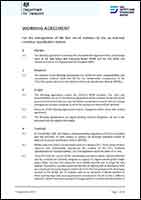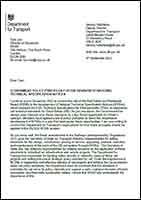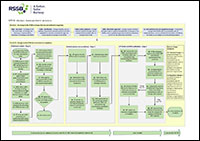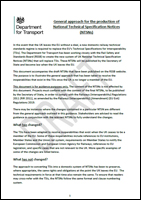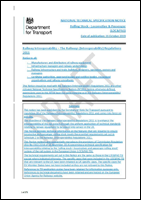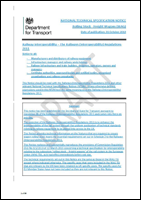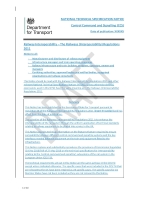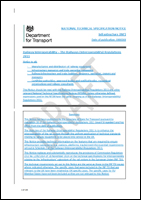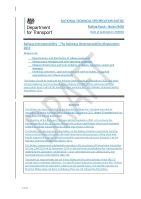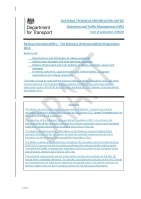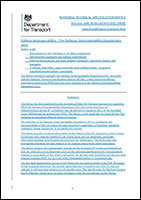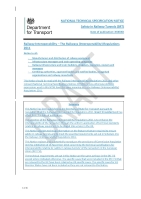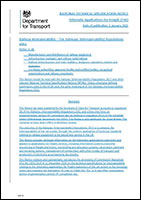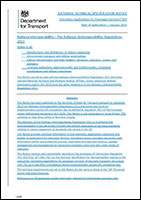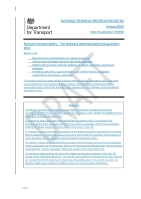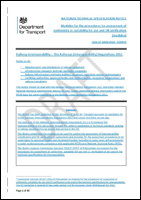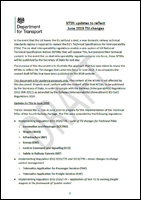National Technical Specification Notices
Following the UK’s exit from the EU and the ending of the transition period on 31 December 2020, EU Technical Specifications for Interoperability (TSIs) have ceased to apply in the UK. The technical content of TSIs at the end of the transition period have been replicated as National Technical Specification Notices (NTSNs), which came into effect on 1 January 2021. These are published by the Secretary of State on the Department for Transport (DfT) website. Track-changed versions of the NTSNs are published below for guidance purposes only. The track-changed versions of the NTSNs show how the NTSNs differ from the corresponding TSIs. The NTSNs published by the Secretary of State are the relevant legal standards to be complied with under the Railways (Interoperability) Regulations 2011 (as amended).
NTSNs define the technical and operational standards which must be met to satisfy the ‘essential requirements’, and to ensure the interoperability of the railway system. This allows all parts of our network to run as a whole system, providing benefits for our customers and our society.
The essential requirements are safety, reliability and availability, health, environmental protection, technical compatibility and accessibility. ‘Interoperability’ is defined in the Railways (Interoperability) Regulations 2011 (as amended) as ‘the ability of the rail system to allow the safe and uninterrupted movement of trains which accomplish the required levels of performance for those lines’.
Who must comply with NTSNs?
The Railways (Interoperability) Regulations 2011 (as amended) mandates compliance with NTSNs on the rail system The scope of the rail system where the NTSNs apply can be found on the DfT website. For further information, see our Complying with Legislation page.
You must comply with an NTSN if you are building new railway sub-systems or carrying out a major upgrade or renewal of an existing railway sub-system. Replacement of parts of a sub-system on a like-for-like basis, for example replacing track with track of a similar specification, does not trigger a legal obligation to comply with NTSNs. The NTSNs also contain requirements for interoperability constituents (ICs).
For further information on ICs see the page on interoperability constituents and the ICs NTSN below.
Advice about whether a specific project must comply with NTSNs can be obtained from the DfT.
How do NTSNs relate to national technical rules?
National technical rules (NTRs) are used for the following purposes:
- To fill identified 'open points' in NTSNs. Open points are identified in an annex to an NTSN if certain technical aspects corresponding to the essential requirements cannot be explicitly covered in the NTSN.
- To support ‘UK specific cases’ in NTSNs. A UK specific case is a special provision relating to the technical specifications for a subsystem or an interoperability constituent to allow for its compatibility with the rail system, which is set out in an NTSN or an NTR.
- To set out requirements to maintain technical compatibility between existing assets (or processes) that do not conform to the requirements of NTSNs and new, upgraded or renewed assets that do conform to NTSNs.
From 1 January 2021, the Railways (Interoperability) Regulations 2011 requires the Secretary of State to publish a list of all NTRs applying in the UK. RSSB recommends to the DfT the list of NTRs contained in Railway Group Standards.
The NTSNs
-
Structural NTSNs
Control Command and Signalling NTSN
The Control Command and Signalling (CCS) NTSN replaces and substantially reproduces the provisions of Commission Regulation (EU) No 2016/919 (the CCS TSI), which were in effect until 23:00 on 31 December 2020. It provides technical information on the features that are required to ensure compatibility between different control-command and signalling systems and the key interfaces needed between equipment on the train and equipment fitted to the infrastructure.
See also GEGN8611 Guidance on the Application of the CCS TSI (this will be amended in due course to reflect the NTSN).
RSSB contact: Alex Savopoulos, Principal Control, Command & Communications Engineer
Energy NTSN
The Energy (ENE) NTSN replaces and substantially reproduces the provisions of Commission Regulation (EU) 1301/2014 (the ENE TSI), which were in effect until 23:00 on 31 December 2020. It provides technical information on the features that are required to ensure that fixed installations required to supply energy to a train meet the essential requirements.
See also:
- GLGN1600 Guidance on the ENE TSI (this will be amended in due course to reflect the NTSN)
- The UK National Implementation Plan for the ENE TSI
RSSB contact: Mike Tatton, Professional Head of Energy
Infrastructure NTSN
The Infrastructure (INF) NTSN replaces and substantially reproduces the provisions of Commission Regulation (EU) 1299/2014 (the INF TSI), which were in effect until 23:00 on 31 December 2020. It provides technical information on the features that are required to ensure infrastructure subsystems (e.g. stations, platforms, tracks) meet the essential requirements.
See also UK National Implementation Plan for the INF TSI (this will be amended in due course to reflect the NTSN).
RSSB contact: Anup Chalisey, Professional Head of Infrastructure
Rolling Stock – Freight Wagons NTSN
The Rolling Stock – Freight Wagons (WAG) NTSN replaces and substantially reproduces the provisions of Commission Regulation (EU) 321/2013 (the WAG TSI), which were in effect until 23:00 on 31 December 2020. It provides technical information on the features that are required to ensure freight wagon rolling stock meets the essential requirements.
See also List of fully UIC approved composite brake blocks for international transport.
RSSB contact: Neil Halliday, Professional Head of Plant
Rolling Stock – Locomotive and Passenger NTSN
The Rolling Stock – Locomotive and Passenger (LOC&PAS) NTSN replaces and substantially reproduces the provisions of Commission Regulation (EU) 1302/2014 (the LOC&PAS TSI), which were in effect until 23:00 on 31 December 2020. It provides technical information on the features that are required to ensure locomotive and passenger rolling stock meets the essential requirements.
See also GMGN2615 Guidance on the LOC&PAS TSI (this will be amended in due course to reflect the NTSN)
RSSB contact: Mark Oakley, Professional Head of Rolling Stock
Rolling Stock – Noise NTSN
The Rolling Stock – Noise (NOI) NTSN replaces and substantially reproduces the provisions of Commission Regulation (EU) 1304/2014 (the NOI TSI) which were in effect until 23:00 on 31 December 2020. It provides technical information on the required level of specification in relation to rolling stock subsystem (for both locomotives and passenger rolling stock, and freight wagons) in order to limit the noise emission of the rail system.
RSSB contact: Neil Halliday, Professional Head of Plant
-
Functional NTSNs
Operation and Traffic Management NTSN
The Operation and Traffic Management (OPE) NTSN replaces and substantially reproduces the provisions of Commission Decision 2012/757/EU (the OPE TSI), which were in effect until 23:00 on 31 December 2020, notwithstanding the publication of Implementing Regulation (EU) 2019/773. It applies to infrastructure managers and railway undertakings and provides technical information for the operation of trains on the rail system to meet the essential requirements.
See also:
- Appendix A to the OPE NTSN
- GOGN3615 Guidance on the OPE TSI (this will be amended in due course to reflect the NTSN)
- GB Railway Implementation Plan for the OPE TSI
RSSB contact: Gary Portsmouth, Professional Head of Rail Operations
Telematic Applications for Freight NTSN
The Telematic Applications for Freight (TAF) NTSN replaces and substantially reproduces the provisions of Commission Regulation (EU) 1305/2014 (the TAF TSI) which were in effect until 23:00 on 31 December 2020. It provides technical information on the telematics applications subsystem and applies to applications for freight services. This includes information systems (real-time monitoring of freight and trains), marshalling and allocation systems, reservation, payment and invoicing systems, management of connections with other modes of transport and production of electronic accompanying documents.
See also:
- TAF TAP information from Network Rail
- Regulation (EU) 2020/1056 on electronic freight transport information.
RSSB contact: Vaibhav Puri, Deputy Director of Standards and Head of Policy.
Telematic Applications for Passenger Services NTSN
The Telematic Applications for Passenger Services (TAP) NTSN replaces and substantially reproduces the provisions of Commission Regulation (EU) 454/2011 (the TAP TSI) which were in effect until 23:00 on 31 December 2020. It provides technical information on the telematics applications subsystem and applies to applications for passenger services. This includes systems providing passengers with information before and during the journey, reservation and payment systems, luggage management and management of connections between trains and with other modes of transport.
See also:
RSSB contact: Vaibhav Puri, Deputy Director of Standards and Head of Policy.
-
Transverse NTSNs (covering more than one railway sub-system)
Persons of Reduced Mobility NTSN
The Persons of Reduced Mobility (PRM) NTSN replaces and substantially reproduces the provisions of Commission Regulation (EU) 1300/2014 (the PRM TSI) which were in effect until 23:00 on 31 December 2020. It provides technical information on the features that are required to make it easier for persons with reduced mobility to use rolling stock, such as handholds, passenger information displays, priority seats and provision for wheelchairs. It also sets accessibility standards for new stations or for stations where major work takes place.
See also:
RSSB contact: Anup Chalisey, Professional Head of Infrastructure
Safety in Railway Tunnels NTSN
The Safety in Railway Tunnels (SRT) NTSN replaces and substantially reproduces the provisions of Commission Regulation (EU) 1303/2014 (the SRT TSI) which were in effect until 23:00 on 31 December 2020. It provides technical information on the features that are required to ensure safety in railway tunnels and how to meet the essential requirements.
RSSB contact: Anup Chalisey, Professional Head of Infrastructure
-
NTSN for assessment of Interoperability Constituents
The ICs NTSN sets out the procedure that must be followed for the assessment of interoperability constituents against UK specific cases. This includes the further assessment of interoperability constituents which hold an ‘EC’ declaration of conformity or suitability for use, which applies in cases where there is an applicable UK specific case for the constituent.
RSSB contact: Vaibhav Puri, Head of Technical & Regulatory Policy
-
NTSN for Conformity Assessment Modules
The NTSN on ‘modules for the procedures for assessment of conformity or suitability for use and UK verification’ replaces Commission Decision 2010/713/EU on ‘modules for the procedures for assessment of conformity, suitability for use and EC verification to be used in the technical specifications for interoperability’.
RSSB contact: Vaibhav Puri, Head of Technical & Regulatory Policy
Changes to NTSNs
NTSNs are DfT-owned technical regulations published by the Secretary of State. At the end of the transition period on 31 December 2020, the technical content of NTSNs aligned with those in the relevant TSIs. Decisions on whether to keep pace with or diverge from future TSIs will be made by the Secretary of State. These decisions will be informed through consultation with industry about the suitability of aligning with changes to TSIs. This consultation will involve RSSB and other industry stakeholders with an interest in technical standards. Such decisions will consider how best to safeguard the interests of passengers, freight users and the industry.
When a reason for updating an NTSN is identified (for example by a change request made by industry or the corresponding TSI is changing), this will trigger a process managed by RSSB. We will consult with industry and prepare a business case for change and impact assessment. This will lead to a recommendation from the relevant Standards Committee, which will be reviewed by the DfT against wider government policy and international commitments (such as COTIF). If the NTSN aligns with the TSI then this is published by the Secretary of State. If the NTSN diverges from the associated TSI, then DfT will notify Parliament through a Written Ministerial Statement before any final decisions are made. Once necessary changes are made further to feedback, the DfT will present the final NTSN text to the Secretary of State for a decision to publish on the DfT website. Further information on the proposed change management process can be found in the resources section below.
-
Coming changes
Revised TSIs were published in the European Union in September 2023. RSSB issued a formal industry recommendation for related revisions to the CCS, INF, LOC&PAS, WAG, NOI, OPE and PRM NTSNs to the DfT on 29 February 2024.
For the revision to the ENE NTSN, industry was not able to reach a consensus. RSSB made a recommendation based on the evidence provided through the review and consultation. RSSB submitted this to the DfT on 15 March 2024.
The documents that RSSB provided to the DfT are published on our consultation portal. This includes the cover letters for the recommendations, the proposed NTSN text, the business case for change, and the consultation comments and responses.
This revision to the NTSNs was limited to addressing previously known issues and principally to consider changes in the TSIs. The scope was constrained in this way as our resources are finite and there is a benefit to realising changes now.
Important and significant issues were raised in the consultation. There are many ways these NTSNs can continue to be improved. These revisions are the first step of progressive improvement. We have recorded matters that were not addressed in this revision and work has already started on some of them.
NTSN issues and change request log
The TSI application issues log has been reproduced into the NTSN issues and change request log. RSSB will manage the NTSN issues and change request log (available in the resources section below) to record information relating to problems that have been encountered when applying NTSNs in GB. This can be used to support discussions when NTSNs are being amended.
Although the log is managed by RSSB, issues may be contributed by anyone, including those on the GB mainline railway and HS1. Where appropriate, a document setting out further information relating to an issue should be included in the log via a hyperlink.
Any issue with an NTSN should be raised with your industry sector representative on the Standards Committee for the relevant railway sub-system.
Strategic direction for NTSNs
The strategic directions for TSIs apply to the NTSNs. These can be found in the ‘Resources’ section of the Technical Specifications for Interoperability page of this website.

